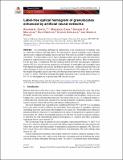Files in this item
Label-free optical hemogram of granulocytes enhanced by artificial neural networks
Item metadata
| dc.contributor.author | Gupta, Roopam | |
| dc.contributor.author | Chen, Mingzhou | |
| dc.contributor.author | Malcolm, Graeme P. A. | |
| dc.contributor.author | Hempler, Nils | |
| dc.contributor.author | Dholakia, Kishan | |
| dc.contributor.author | Powis, Simon John | |
| dc.date.accessioned | 2019-04-30T13:30:45Z | |
| dc.date.available | 2019-04-30T13:30:45Z | |
| dc.date.issued | 2019-05-13 | |
| dc.identifier | 258306534 | |
| dc.identifier | c167eb68-17c1-4aa7-8d48-5b37d5894cd3 | |
| dc.identifier | 85065831289 | |
| dc.identifier | 000469220500012 | |
| dc.identifier.citation | Gupta , R , Chen , M , Malcolm , G P A , Hempler , N , Dholakia , K & Powis , S J 2019 , ' Label-free optical hemogram of granulocytes enhanced by artificial neural networks ' , Optics Express , vol. 27 , no. 10 , pp. 13706-13720 . https://doi.org/10.1364/OE.27.013706 | en |
| dc.identifier.issn | 1094-4087 | |
| dc.identifier.other | ORCID: /0000-0002-6190-5167/work/57088508 | |
| dc.identifier.other | ORCID: /0000-0002-3267-9009/work/57088538 | |
| dc.identifier.other | ORCID: /0000-0003-4218-2984/work/60195302 | |
| dc.identifier.uri | https://hdl.handle.net/10023/17612 | |
| dc.description | Funding: Medical Research Scotland (PhD873-2015) and the UK Engineering and Physical Sciences Research Council through grants EP/R004854/1 and EP/P030017/1. | en |
| dc.description.abstract | An outstanding challenge for immunology is the classification of immune cells in a label-free fashion with high speed. For this purpose, optical techniques such as Raman spectroscopy or digital holographic microscopy have been used successfully to identify immune cell subsets. To achieve high accuracy, these techniques require a post-processing step using linear methods of multivariate processing, such as principal component analysis. Here we demonstrate for the first time a comparison between artificial neural networks and principal component analysis (PCA) to classify the key granulocyte cell lineages of neutrophils and eosinophils using both digital holographic microscopy and Raman spectroscopy. Artificial neural networks can offer advantages in terms of classification accuracy and speed over a PCA approach. We conclude that digital holographic microscopy with convolutional neural networks based analysis provides a route to a robust, stand-alone and high-throughput hemogram with a classification accuracy of 91.3 % at a throughput rate of greater than 100 cells per second. | |
| dc.format.extent | 15 | |
| dc.format.extent | 2624545 | |
| dc.language.iso | eng | |
| dc.relation.ispartof | Optics Express | en |
| dc.subject | Deep learning | en |
| dc.subject | Machine Learning | en |
| dc.subject | Artificial Neural Networks | en |
| dc.subject | Raman Spectroscopy | en |
| dc.subject | Digital holographic microscopy | en |
| dc.subject | immunology | en |
| dc.subject | QA75 Electronic computers. Computer science | en |
| dc.subject | QC Physics | en |
| dc.subject | QR180 Immunology | en |
| dc.subject | T Technology | en |
| dc.subject | DAS | en |
| dc.subject.lcc | QA75 | en |
| dc.subject.lcc | QC | en |
| dc.subject.lcc | QR180 | en |
| dc.subject.lcc | T | en |
| dc.title | Label-free optical hemogram of granulocytes enhanced by artificial neural networks | en |
| dc.type | Journal article | en |
| dc.contributor.sponsor | EPSRC | en |
| dc.contributor.sponsor | EPSRC | en |
| dc.contributor.institution | University of St Andrews. School of Medicine | en |
| dc.contributor.institution | University of St Andrews. School of Physics and Astronomy | en |
| dc.contributor.institution | University of St Andrews. Biomedical Sciences Research Complex | en |
| dc.contributor.institution | University of St Andrews. Cellular Medicine Division | en |
| dc.contributor.institution | University of St Andrews. Centre for Biophotonics | en |
| dc.identifier.doi | https://doi.org/10.1364/OE.27.013706 | |
| dc.description.status | Peer reviewed | en |
| dc.identifier.grantnumber | EP/R004854/1 | en |
| dc.identifier.grantnumber | EP/P030017/1 | en |
This item appears in the following Collection(s)
Items in the St Andrews Research Repository are protected by copyright, with all rights reserved, unless otherwise indicated.

